Enjoying the Festivalscape: The Effect of Festival Cues in Live-Streaming Studios on Consumers’ Intention to Stay
Abstract
1. Introduction
2. Literature Review and Hypothesis Development
2.1. Festivals and Festival Cues
2.2. Festival Cues and Consumers’ Intention to Stay
2.3. The Mediating Roles of Festivalscape Perceptions and Pleasure–Arousal
2.4. The Moderating Effect of Product Category
2.5. The Moderating Role of Involvement
3. Study 1a
3.1. Design and Procedure
3.2. Measures
3.3. Results
4. Study 1b
4.1. Design and Procedure
4.2. Measures
4.3. Results
5. Study 2
5.1. Procedure and Measures
5.2. Results
6. Study 3
6.1. Procedures and Measures
6.2. Results
7. General Discussion
7.1. Conclusions
7.2. Theoretical Implications
7.3. Managerial Implications
7.4. Limitations and Future Research Avenues
Author Contributions
Funding
Institutional Review Board Statement
Informed Consent Statement
Data Availability Statement
Conflicts of Interest
Appendix A
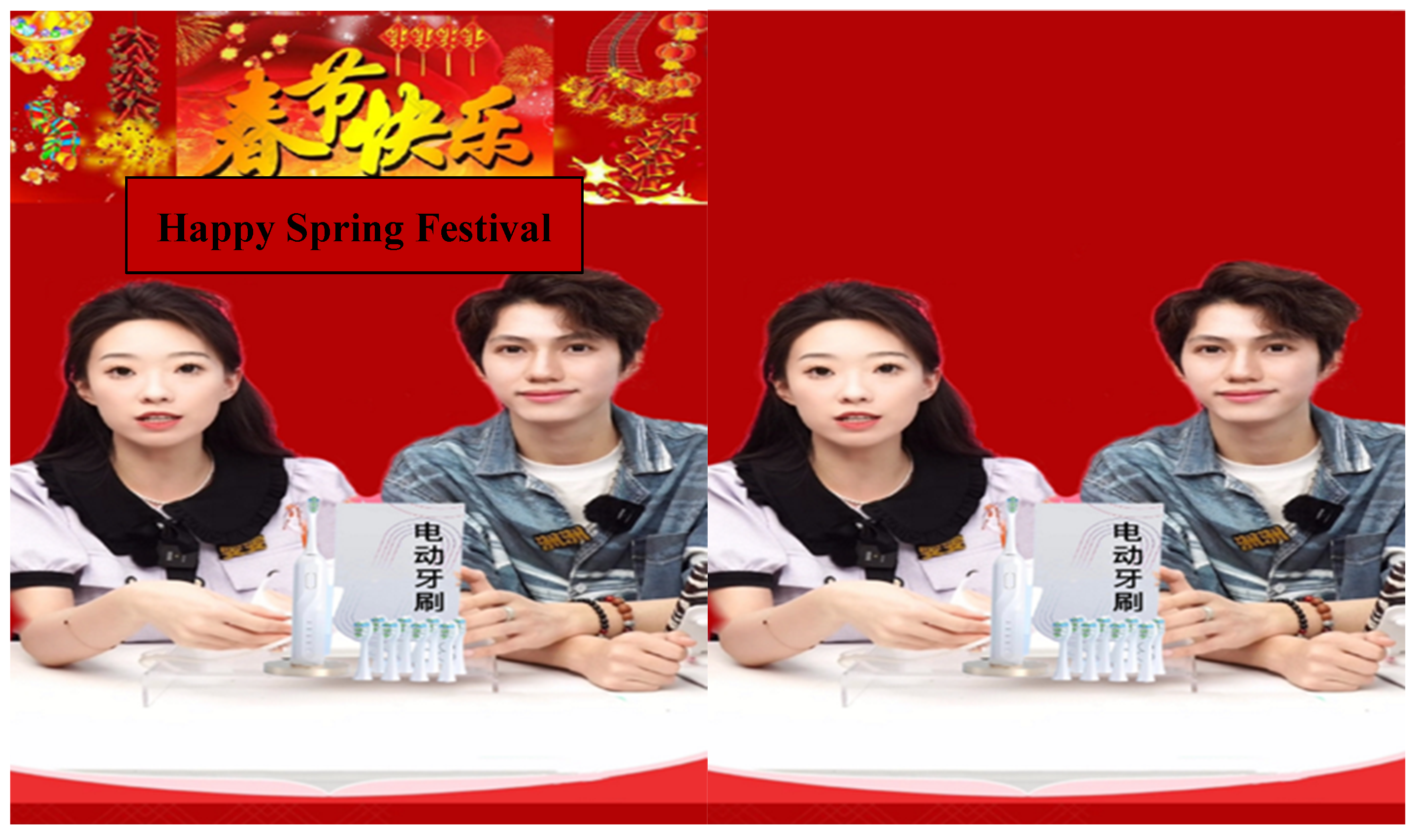


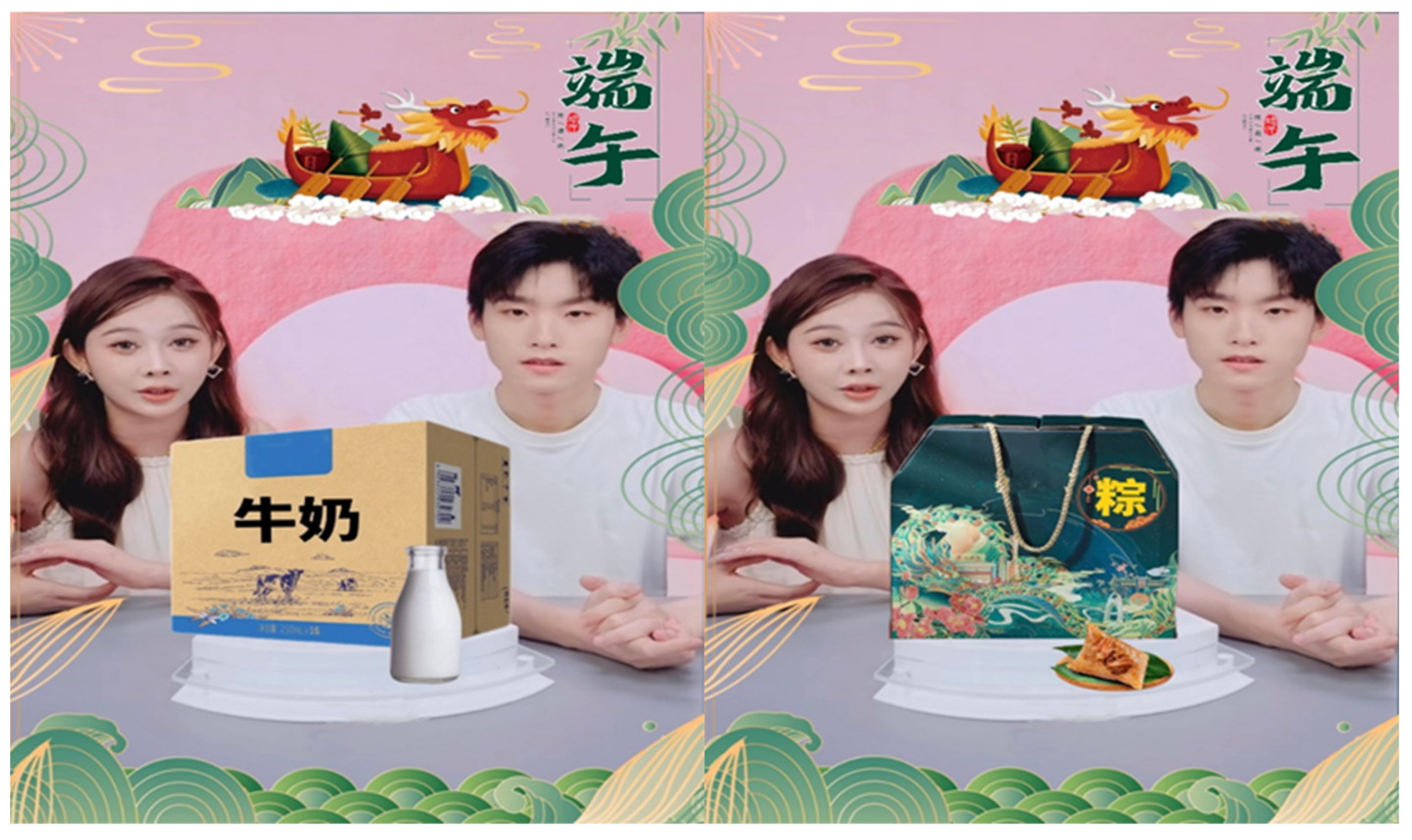
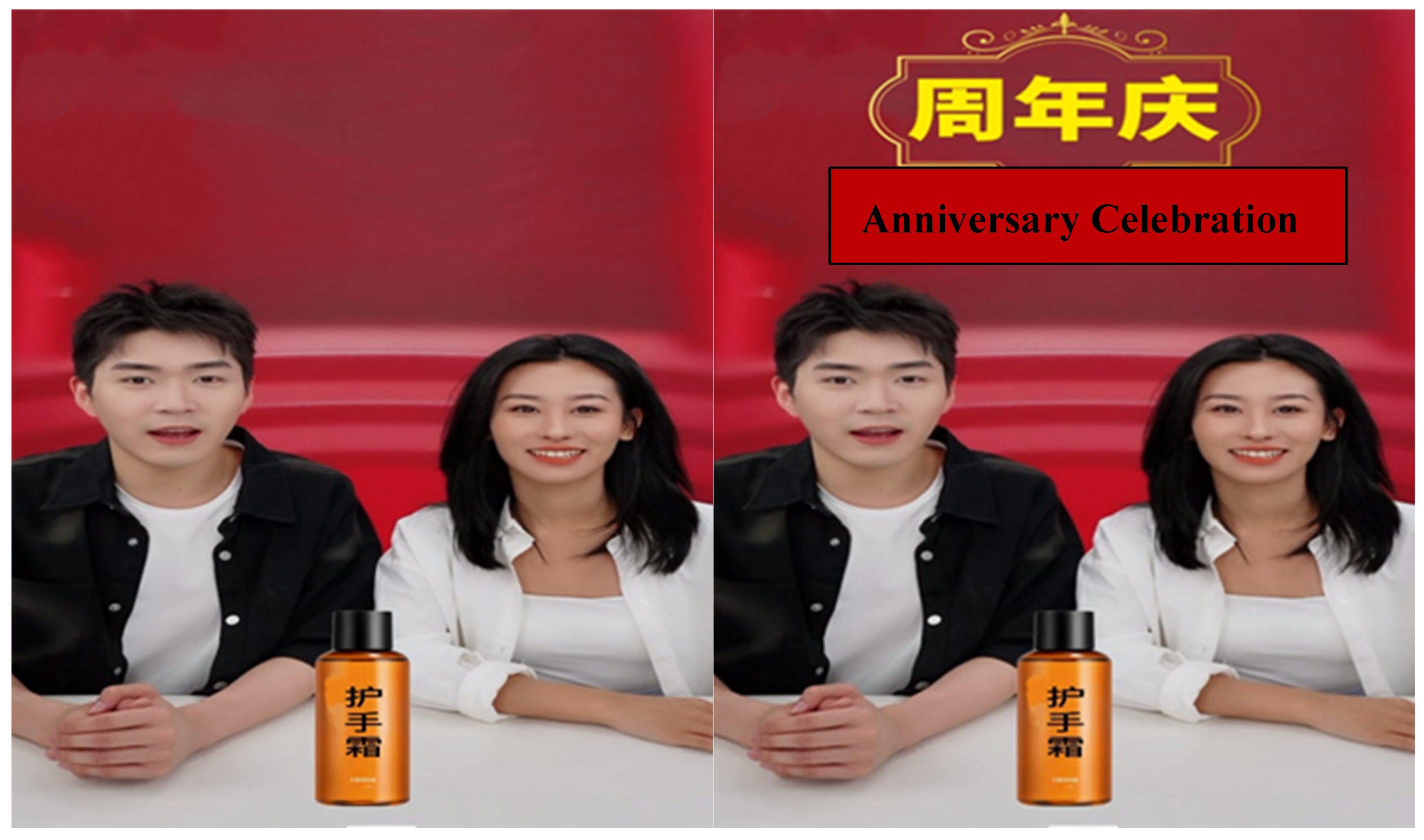
Appendix B
| Outcome | β | BootSE | BootLLCI | BootULCI |
|---|---|---|---|---|
| Direct effect Festival cues-Consumers’ intention to stay | -.5387 | .2119 | -.9581 | -.1174 |
| Indirect effect Festival cues-Festivalscape perception-Consumers’ intention to stay | .4038 | .1971 | .0736 | .8606 |
| Festival cues-Pleasure arousal-Consumers’ intention to stay | .3564 | .1580 | .0743 | .7044 |
| Festival cues-Festivalscape perception-Pleasure arousal-Consumers’ intention to stay | -.7458 | .1887 | -1.2065 | -.4426 |
| Outcome | β | BootSE | BootLLCI | BootULCI |
|---|---|---|---|---|
| Direct effect Festival cues-Consumers’ intention to stay | -.4341 | .1842 | -.7975 | -.0707 |
| Indirect effect Festival cues-Festivalscape perception-Consumers’ intention to stay | .4990 | .1669 | .2044 | .8561 |
| Festival cues-Pleasure arousal-Consumers’ intention to stay | .3091 | .1413 | .0465 | .5930 |
| Festival cues-Festivalscape perception-Pleasure arousal-Consumers’ intention to stay | -1.1442 | .1783 | -1.5478 | -.8337 |
References
- Cunningham, S.; Craig, D.; Lv, J. China’s livestreaming industry: Platforms, politics, and precarity. Int. J. Cult. Stud. 2019, 22, 719–736. [Google Scholar] [CrossRef]
- CNNIC (China Internet Network Information Centre). The 53rd Statistical Report on China’s Internet Development; CNNIC: Beijing, China, 2024; pp. 48–49. Available online: https://www.cnnic.com.cn/IDR/ReportDownloads/202405/P020240509518443205347.pdf (accessed on 22 March 2024).
- Ang, T.; Wei, S.; Anaza, N.A. Livestreaming vs. pre-recorded: How social viewing strategies impact consumers’ viewing experiences and behavioral intentions. Eur. J. Mark. 2018, 52, 2075–2104. [Google Scholar] [CrossRef]
- Lo, P.S.; Dwivedi, Y.K.; Tan, W.H.; Ooi, K.B.; Aw, C.X.; Metri, B.; Woodside, A.G. Why do consumers buy impulsively during live streaming? A deep learning-based dual-stage SEM-ANN analysis. J. Bus. Res. 2022, 147, 325–337. [Google Scholar] [CrossRef]
- Wongkitrungrueng, A.; Assarut, N. The role of live streaming in building consumer trust and engagement with social commerce sellers. J. Bus. Res. 2020, 117, 543–556. [Google Scholar] [CrossRef]
- Yang, X.; Liu, Y.; Dong, J.; Li, S. Impact of streamers? Characteristics on sales performance of search and experience products: Evidence from Douyin. J. Retail. Consum. Serv. 2023, 70, 103155. [Google Scholar] [CrossRef]
- Chen, C.; Li, X. Effects of Singles’ Day atmosphere stimuli and Confucian values on consumer purchase intention. Asia Pac. J. Mark. Logist. 2020, 32, 1387–1405. [Google Scholar] [CrossRef]
- Smith, M.F. Urban versus suburban consumers: A contrast in holiday shopping purchase intentions and outshopping behavior. J. Consum. Mark. 1999, 16, 58–73. [Google Scholar] [CrossRef]
- Wang, T.; Chen, R. It reminds me of my happy childhood: The influence of a brand logo’s holiday atmosphere on merchandise-related nostalgic preference. J. Theor. Appl. Electron. Commer. Res. 2022, 17, 1019–1034. [Google Scholar] [CrossRef]
- Lee, Y.K.; Lee, C.K.; Lee, S.K.; Babin, B.J. Festivalscapes and patrons’ emotions, satisfaction, and loyalty. J. Bus. Res. 2008, 61, 56–64. [Google Scholar] [CrossRef]
- Tanford, S.; Jung, S. Festival attributes and perceptions: A meta-analysis of relationships with satisfaction and loyalty. Tour. Manag. 2017, 61, 209–220. [Google Scholar] [CrossRef]
- McKercher, B.; Mei, W.S.; Tse, T.S.M. Are short duration cultural festivals tourist attractions. J. Sustain. Tour. 2006, 14, 55–66. [Google Scholar] [CrossRef]
- Litvin, S.W.; Fetter, E. Can a festival be too successful? A review of Spoleto, USA. Int. J. Contemp. Hosp. Manag. 2006, 18, 41–49. [Google Scholar] [CrossRef]
- Spangenberg, E.R.; Grohmann, B.; Sprott, D.E. It’s beginning to smell (and sound) a lot like Christmas: The interactive effects of ambient scent and music in a retail setting. J. Bus. Res. 2005, 58, 1583–1589. [Google Scholar] [CrossRef]
- Cartwright, J.; McCormick, H.; Warnaby, G. Consumers’ emotional responses to the Christmas TV advertising of four retail brands. J. Retail. Consum. Serv. 2016, 29, 82–91. [Google Scholar] [CrossRef]
- Davis, A. Experiential places or places of experience? place identity and place attachment as mechanisms for creating festival environment. Tour. Manag. 2016, 55, 49–61. [Google Scholar] [CrossRef]
- Lee, J.-S.; Lee, C.-K.; Choi, Y. Examining the role of emotional and functional values in festival evaluation. J. Travel Res. 2011, 50, 685–696. [Google Scholar] [CrossRef]
- Eroglu, S.A.; Machleit, K.A.; Davis, L.M. Atmospheric qualities of online retailing: A conceptual model and implications. J. Bus. Res. 2001, 54, 177–184. [Google Scholar] [CrossRef]
- Mehrabian, A.; Russell, J.A. An Approach to Environmental Psychology; MIT Press: Cambridge, MA, USA, 1974. [Google Scholar]
- Varshneya, G.; Das, G. Experiential value: Multi-item scale development and validation. J. Retail. Consum. Serv. 2017, 34, 48–57. [Google Scholar] [CrossRef]
- Roy, S.K.; Lassar, W.M.; Butaney, G.T. The mediating impact of stickiness and loyalty on word-of-mouth promotion of retail websites. Eur. J. Mark. 2014, 48, 1828–1849. [Google Scholar]
- Ettis, S.A. Examining the relationships between online store atmospheric color, flow experience and consumer behavior. J. Retail. Consum. Serv. 2017, 37, 43–55. [Google Scholar] [CrossRef]
- Sina, A.S.; Wu, J. Effects of 3D vs. 2D interfaces and product-coordination methods. Int. J. Retail Distrib. Manag. 2019, 47, 855–871. [Google Scholar] [CrossRef]
- Lee, Y.; Kim, H.-Y. Consumer need for mobile app atmospherics and its relationships to shopper responses. J. Retail. Consum. Serv. 2019, 51, 437–442. [Google Scholar] [CrossRef]
- Hoffman, D.L.; Novak, T.P. Marketing in hypermedia computer-mediated environments: Conceptual foundations. J. Mark. 1996, 60, 50–68. [Google Scholar] [CrossRef]
- Kim, S.; Baek, T.H.; Kim, Y.-K.; Yoo, K. Factors affecting stickiness and word of mouth in mobile applications. J. Res. Interact. Mark. 2016, 10, 177–192. [Google Scholar] [CrossRef]
- Lin, L.; Hu, P.J.H.; Sheng, O.R.L.; Lee, J. Is stickiness profitable for electronic retailers? Commun. ACM 2010, 53, 132–136. [Google Scholar] [CrossRef]
- Hausman, A.V.; Siekpe, J.S. The effect of web interface features on consumer online purchase intentions. J. Bus. Res. 2009, 62, 5–13. [Google Scholar] [CrossRef]
- Reydet, S.; Carasana, L. The effect of digital design in retail banking on customers’ commitment and loyalty: The mediating role of positive affect. J. Retail. Consum. Serv. 2017, 37, 132–138. [Google Scholar] [CrossRef]
- Kim, W.G.; Moon, Y.J. Customers’ cognitive, emotional, and actionable response to the servicescape: A test of the moderating effect of the restaurant type. Int. J. Hosp. Manag. 2009, 28, 144–156. [Google Scholar] [CrossRef]
- Mason, M.C.; Paggiaro, A. Investigating the role of festivalscape in culinary tourism: The case of food and wine events. Tour. Manag. 2012, 33, 1329–1336. [Google Scholar] [CrossRef]
- Bagozzi, R.P. Principles of Marketing Management; Science Research Associates: Chicago, IL, USA, 1986. [Google Scholar]
- Bitner, M.J. Servicescapes: The impact of physical surroundings on customers and employees. J. Mark. 1992, 56, 57–71. [Google Scholar] [CrossRef]
- Eroglu, S.A.; Machleit, K.A.; Davis, L.M. Empirical testing of a model of online store atmospherics and shopper responses. Psychol. Mark. 2003, 20, 139–150. [Google Scholar] [CrossRef]
- Park, J.Y.; Back, R.M.; Bufquin, D.; Shapoval, V. Servicescape, positive affect, satisfaction and behavioral intentions: The moderating role of familiarity. Int. J. Hosp. Manag. 2019, 78, 102–111. [Google Scholar] [CrossRef]
- Cheng, F.F.; Wu, C.S.; Yen, D.C. The effect of online store atmosphere on consumer’s emotional responses—An experimental study of music and color. Behav. Inf. Technol. 2009, 28, 323–334. [Google Scholar] [CrossRef]
- Mitchell, V.W.; Davies, F.; Moutinho, L.; Vassos, V. Using neural networks to understand service risk in the holiday product. J. Bus. Res. 1999, 46, 167–180. [Google Scholar] [CrossRef]
- Campbell, M.C. When attention-getting advertising tactics elicit consumer inferences of manipulative intent: The importance of balancing benefits and investments. J. Consum. Psychol. 1995, 4, 225–254. [Google Scholar] [CrossRef]
- Ha, Y.; Lennon, S.J. Online visual merchandising (VMD) cues and consumer pleasure and arousal: Purchasing versus browsing situation. Psychol. Mark. 2010, 27, 141–165. [Google Scholar] [CrossRef]
- Goh, D.; Chi, J. Central or peripheral? Information elaboration cues on childhood vaccination in an online parenting forum. Comput. Hum. Behav. 2017, 69, 181–188. [Google Scholar] [CrossRef]
- Wu, R.; Wu, H.; Wang, C.L. Why is a picture worth a thousand word? Pictures as information in perceived helpfulness of online reviews. Int. J. Consum. Stud. 2021, 45, 364–378. [Google Scholar] [CrossRef]
- Petty, R.E.; Cacioppo, J.T. Source factors and the elaboration likelihood model of persuasion. Adv. Consum. Res. 1984, 11, 668–672. [Google Scholar]
- SanJosé-Cabezudo, R.; Gutiérrez-Arranz, A.M.; Gutiérrez-Cillán, J. The combined influence of central and peripheral routes in the online persuasion process. Cyber Psychol. Behav. 2009, 12, 299–308. [Google Scholar] [CrossRef]
- Chen, S.H.; Lee, K.P. The role of personality traits and perceived value in persuasion: An elaboration likelihood model perspective on online shopping. Soc. Behav. Personal. 2008, 36, 1379–1400. [Google Scholar] [CrossRef]
- Voss, K.E.; Spangenberg, E.R.; Grohmann, B. Measuring the hedonic and utilitarian dimensions of consumer attitude. J. Mark. Res. 2003, 40, 310–321. [Google Scholar] [CrossRef]
- Macinnis, D.J.; Moorman, C.; Jaworski, B.J. Enhancing and measuring consumers’ motivation, opportunity, and ability to process brand information from advertisements. J. Mark. 1991, 55, 32–53. [Google Scholar] [CrossRef]
- Wu, R.; Han, Y.; Chen, S. Awe or excitement? the interaction effects of image emotion and scenic spot type on the perception of helpfulness. J. Hosp. Tour. Manag. 2024, 58, 76–84. [Google Scholar] [CrossRef]
- Hayes, A.F. Introduction to Mediation, Moderation, and Conditional Process Analysis. A Regression-Based Approach, 2nd ed.; The Guilford Press: New York, NY, USA, 2018; ISBN 9781609182304. [Google Scholar]
- Zhang, S.; Huang, C.; Li, X.; Ren, A. Characteristics and roles of streamers in e-commerce live streaming. Serv. Ind. J. 2022, 42, 1001–1029. [Google Scholar] [CrossRef]
- Zhao, K.; Hu, Y.; Hong, Y.; Westland, J.C. Understanding characteristics of popular streamers on live streaming platforms: Evidence from Twitch.tv. J. Assoc. Inf. Syst. 2021, 22, 1076–1098. [Google Scholar] [CrossRef]
- Guo, Y.; Zhang, K.; Wang, C. Way to success: Understanding top streamer’s popularity and influence from the perspective of source characteristics. J. Retail. Consum. Serv. 2022, 64, 102786. [Google Scholar] [CrossRef]
- Meng, Z.Y.; Lin, M.Y. The driving factors analysis of live streamers’ characteristics and perceived value for consumer repurchase intention on live streaming platforms. J. Organ. End User Comput. 2023, 35, 323187. [Google Scholar] [CrossRef]
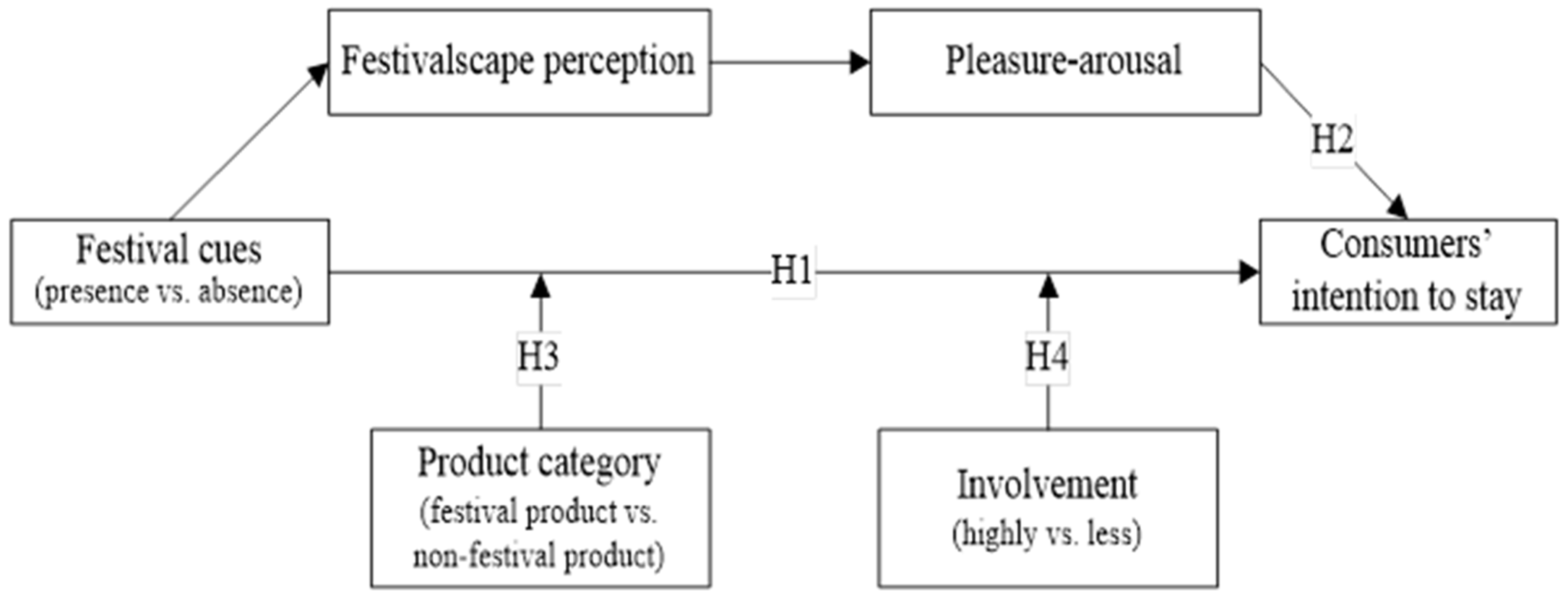

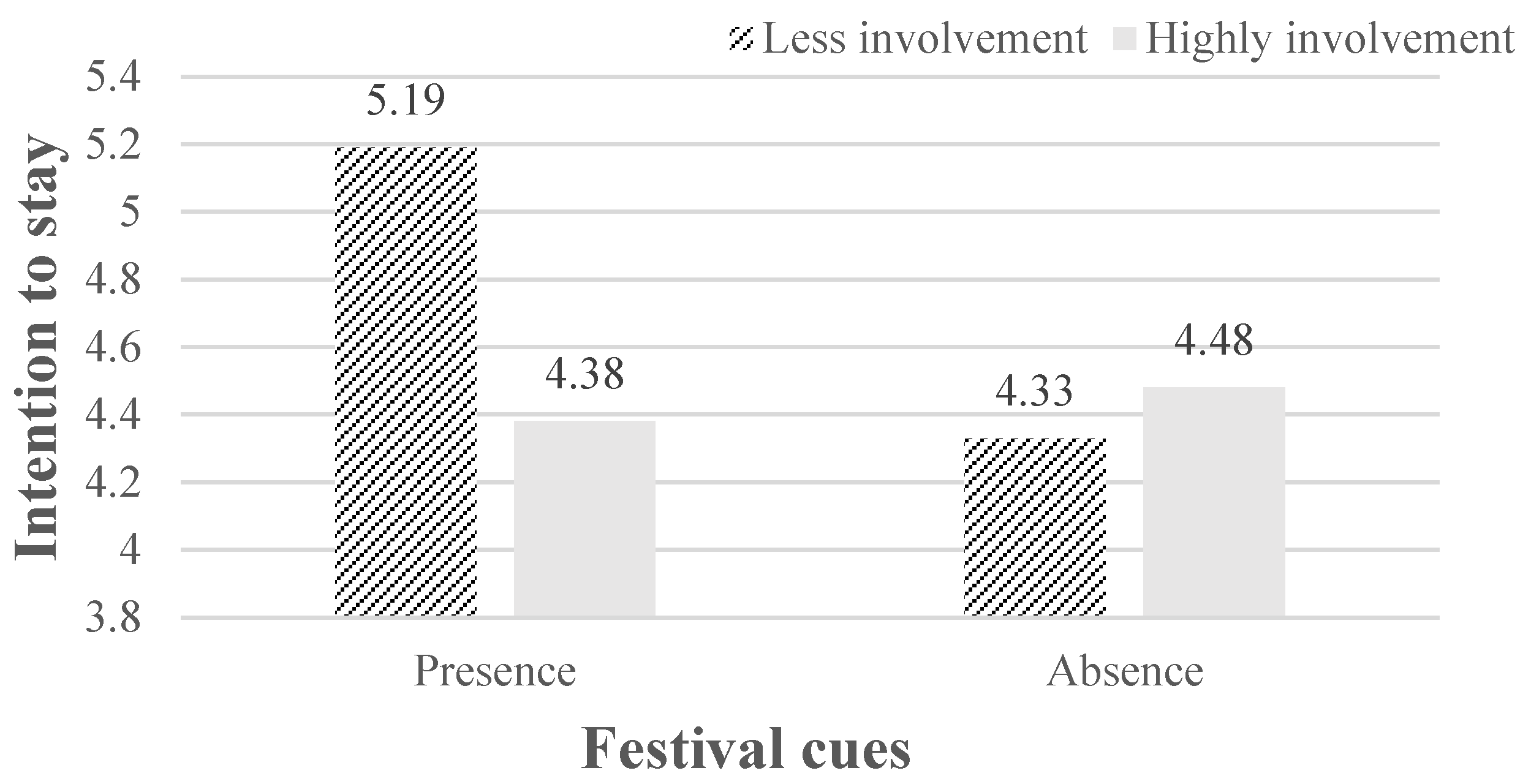
Disclaimer/Publisher’s Note: The statements, opinions and data contained in all publications are solely those of the individual author(s) and contributor(s) and not of MDPI and/or the editor(s). MDPI and/or the editor(s) disclaim responsibility for any injury to people or property resulting from any ideas, methods, instructions or products referred to in the content. |
© 2025 by the authors. Licensee MDPI, Basel, Switzerland. This article is an open access article distributed under the terms and conditions of the Creative Commons Attribution (CC BY) license (https://creativecommons.org/licenses/by/4.0/).
Share and Cite
Wu, R.; Jin, H. Enjoying the Festivalscape: The Effect of Festival Cues in Live-Streaming Studios on Consumers’ Intention to Stay. J. Theor. Appl. Electron. Commer. Res. 2025, 20, 116. https://doi.org/10.3390/jtaer20020116
Wu R, Jin H. Enjoying the Festivalscape: The Effect of Festival Cues in Live-Streaming Studios on Consumers’ Intention to Stay. Journal of Theoretical and Applied Electronic Commerce Research. 2025; 20(2):116. https://doi.org/10.3390/jtaer20020116
Chicago/Turabian StyleWu, Ruijuan, and Huizhen Jin. 2025. "Enjoying the Festivalscape: The Effect of Festival Cues in Live-Streaming Studios on Consumers’ Intention to Stay" Journal of Theoretical and Applied Electronic Commerce Research 20, no. 2: 116. https://doi.org/10.3390/jtaer20020116
APA StyleWu, R., & Jin, H. (2025). Enjoying the Festivalscape: The Effect of Festival Cues in Live-Streaming Studios on Consumers’ Intention to Stay. Journal of Theoretical and Applied Electronic Commerce Research, 20(2), 116. https://doi.org/10.3390/jtaer20020116






